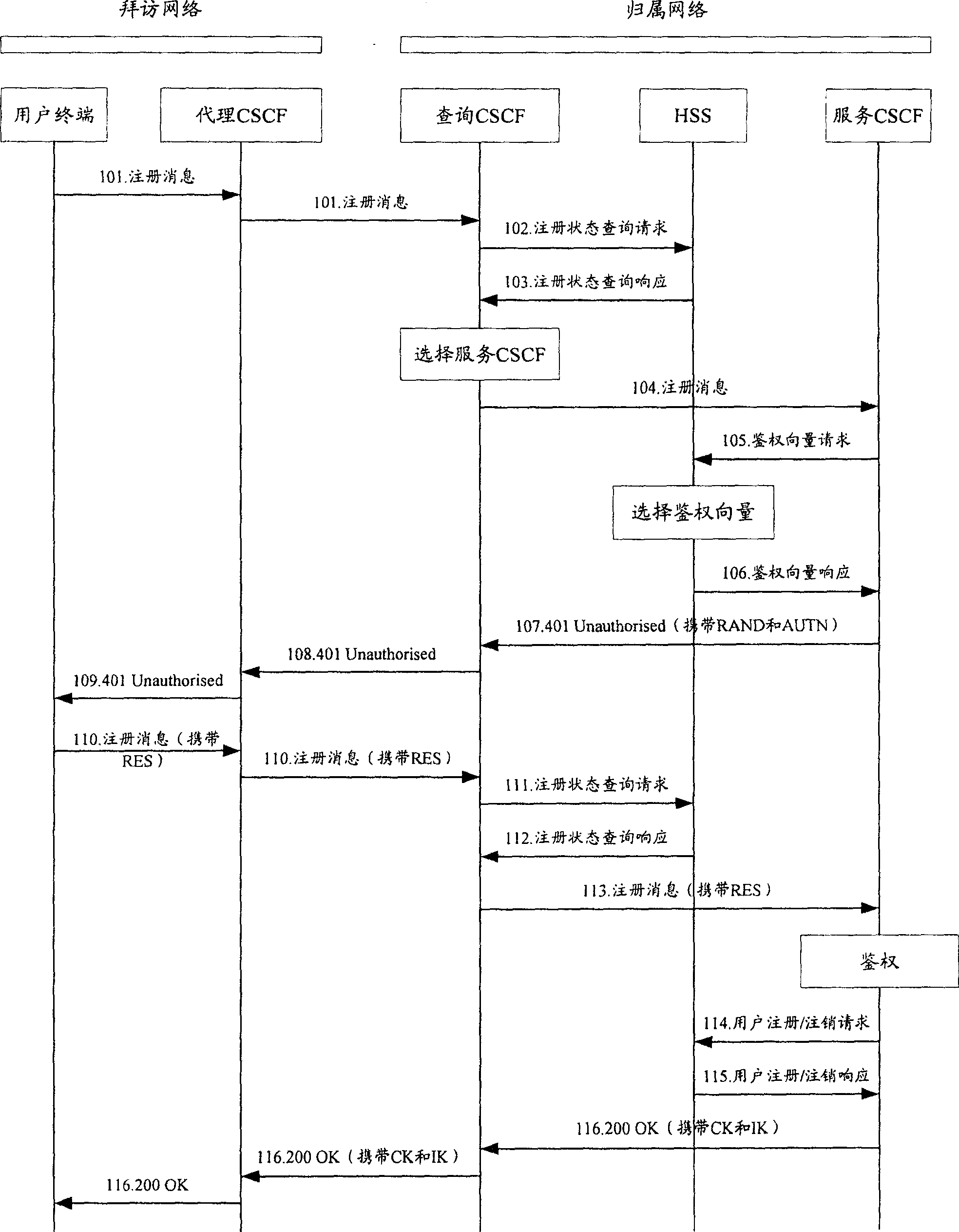User registration/cancel service CSCF name consistency checking method
A checking method and consistency technology, applied to electrical components, transmission systems, etc., can solve problems such as confusing response message analysis, no processing method given, and call operations that cannot be executed correctly, so as to achieve the effect of ensuring consistency
- Summary
- Abstract
- Description
- Claims
- Application Information
AI Technical Summary
Problems solved by technology
Method used
Image
Examples
Embodiment 1
[0043] Embodiment 1, the user initial registration process, such as figure 1 shown.
[0044] Step 101, the user terminal (UE) sends a Register message to the Proxy CSCF (P-CSCF), and the P-CSCF forwards the Register message to the Inquiring CSCF (I-CSCF).
[0045] In steps 102-103, the I-CSCF sends a Registration Status Query Request (UAR) message to the HSS. After receiving the UAR message, the HSS sends the user's capability set information to the I-CSCF through a Registration Status Query Response (UAA) message.
[0046] In the above steps, since the HSS does not save the user's S-CSCF Name, the HSS determines that the user is initially registered, and the HSS sends the user's capability set information to the I-CSCF for subsequent processing.
[0047] Step 104: The I-CSCF selects an S-CSCF that can meet the requirements for the user according to the capability set information, and sends a Register message to the selected S-CSCF.
[0048] Steps 105-106: After receiving th...
Embodiment 2
[0057] Embodiment 2, the user re-registers or cancels (re-registers / logs-off) process, such as figure 2 shown.
[0058] Step 201, the UE sends a registration / deregistration (Register) message to the P-CSCF, and the P-CSCF forwards the registration / deregistration request message to the I-CSCF. The Register message carries parameters for distinguishing whether the message is for performing a registration operation or a logout operation.
[0059] In steps 202-204, the I-CSCF obtains the routing information of the user from the HSS through the UAR / UAA message, and sends the registration / deregistration request message to the corresponding S-CSCF according to the S-CSCF Name in the routing information.
[0060] In the above steps, since the HSS stores the user's S-CSCF Name, the HSS determines that the user is not initially registered, and the HSS sends the user's S-CSCF Name to the I-CSCF for subsequent processing.
[0061] Steps 205-206: After receiving the registration / deregis...
Embodiment 3
[0065] Embodiment three, unregistered user is called the process, such as image 3 shown.
[0066] Steps 301-302: The inquiring CSCF receives an INVITE message calling an unregistered user in the local network, and sends a user location inquiry request (LIR) message to the HSS.
[0067] Step 303: The HSS replies a user location inquiry response (LIA) message to the I-CSCF, and the LIA message includes the capability set information of the user.
[0068] In steps 304-305, the I-CSCF selects an S-CSCF that meets the requirements according to the capability set information, and sends an INVITE message to the selected S-CSCF.
[0069] Step 306: After receiving the INVITE message, the S-CSCF registers the user with the HSS through the SAR message. The SAR message contains the S-CSCF Name, and the Server AssignmetType parameter in the message is UNREGISTERED USER.
[0070] Step 307: After receiving the SAR message, the HSS obtains the S-CSCF Name in the SAR message and replies the...
PUM
 Login to View More
Login to View More Abstract
Description
Claims
Application Information
 Login to View More
Login to View More - R&D
- Intellectual Property
- Life Sciences
- Materials
- Tech Scout
- Unparalleled Data Quality
- Higher Quality Content
- 60% Fewer Hallucinations
Browse by: Latest US Patents, China's latest patents, Technical Efficacy Thesaurus, Application Domain, Technology Topic, Popular Technical Reports.
© 2025 PatSnap. All rights reserved.Legal|Privacy policy|Modern Slavery Act Transparency Statement|Sitemap|About US| Contact US: help@patsnap.com



